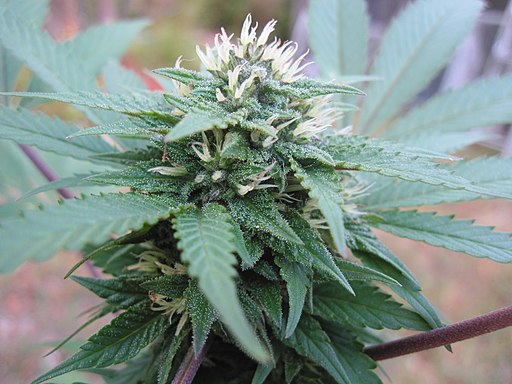Cannabis produces secondary metabolites like cannabinoids and terpenes in response to stressors like ultraviolet light or predatory attacks. The current tally of these molecules stands at a whopping 545, which includes 104 cannabinoids, 120 terpenoids (including 61 monoterpenoids, 52 sesquiterpenoids, and 5 triterpenoids), 26 flavonoids, and 11 steroids. [1]
Because desired molecules like cannabinoids and terpenes are concentrated most in female flowers, these buds are plucked for sale, leaving many parts of the plant unused. Plus, regulatory requirements to destroy cannabis “waste” products may not allow interested parties to valorize the biomass by extracting beneficial phytochemicals, maximizing the most from their cultivation efforts and resources.
A triterpenoid in cannabis roots called friedelin, for example, has shown anti-inflammatory, anticancer, and antioxidant properties. [2] Sterols within the plant may reduce cholesterol levels. [3] And then there’s entourage or ensemble effects from the combination of two or more secondary metabolites.
A recent study evaluated the potential of the other parts of the cannabis plant. [4] Cannabinoid levels in the roots were on the order of 0.001% to 0.004%, so not much at all. Stem barks had a bit more at 0.005% to 0.008%. Cannabis leaves, however, showed 1.10% to 2.10% total cannabinoids.
No mono- or sesquiterpenoids were found in the stem bark or root samples, but the leaves tested between 0.13% to 0.28%. The dominant terpenes/terpenoids found in the leaves were beta-caryophyllene, trans-beta-farnesene, alpha-humulene, trans-nerolidol, and alpha-pinene. Others like alpha-bisabolol, beta-pinene, limonene, beta-myrcene, and linalool were also detected. Triterpenoids β-amyrin, epifriedelanol, and friedelin were summed to provide total triterpenoid content. These molecules ranked lowest in the flowers, followed by the leaves (< 0.05%), stem barks (0.05% to 0.15%), and roots (0.1% to 0.3%). Friedelin was the dominant triterpenoid in cultivars investigated.
To date, 26 flavonoids have been reported in cannabis including orientin, vitexin, isovitexin, quercetin, luteolin, kaempferol, and apigenin. [5] These seven flavonoids were summed to provide total flavonoid content. No flavonoids were detected in the roots or stem barks and there was a minimal amount found in cannabis flowers (0.07% to 0.14%). The leaves, however, showed total flavonoid contents between 0.34% and 0.44%. Vitexin proved to be the dominant flavonoid detected (0.12% to 0.17% in leaves) with orientin ranking second (0.07% to 0.08%). Vitexin demonstrates antioxidant, anti-cancer, anti-inflammatory, anti-hyperalgesic, and neuroprotective effects. [6] Orientin has similar physiological properties, as well as anti-aging, anti-depressant, antiviral, and cardioprotective effects. [7]
The sterols campesterol, stigmasterol, and β-sitosterol were summed to provide the total sterol content. β-sitosterol was the dominant sterol (0.04% to 0.06%) in the cannabis roots and stem barks for the cultivars studied. Stigmasterol was lowest in the roots and stem barks, but highest in the leaves.
Molecular concentrations of > 0.05% are said to be pharmacologically of interest. [8] Gingko biloba is considered one of the higher flavonoid-containing plants with concentrations reported near 0.4%. [9] In this study, cannabis leaves demonstrated similar contents of 0.34% to 0.44%. This study demonstrates that there’s a lot more to the biopharmacy within cannabis than just cannabinoid and terpenes within the inflorescences, despite how amazing those groups really are. It’s a shame to squander the full potential that the other parts of the plant offer, and regulators would be wise to reconsider their destructive policies.
References
[1] ElSohly M. A. & Gul W. Constituents of Cannabis sativa. in Handbook of Cannabis 3–22 Oxford University Press. 2014.[2] Ryz NR, Remillard DJ, Russo EB. Cannabis roots: A traditional therapy with future potential for treating inflammation and pain. Cannabis Cannabinoid Res. 2017;2(1):210-216. [journal impact factor = N/A; times cited = 10]
[3] Ras RT, Geleijnse JM, Trautwein EA. LDL-cholesterol-lowering effect of plant sterols and stanols across different dose ranges: a meta-analysis of randomised controlled studies. Br J Nutr. 2014;112(2):214-219. [journal impact factor = 3.334; times cited = 228]
[4] Jin D, Dai K, Xie Z, Chen J. Secondary metabolites profiled in Cannabis inflorescences, leaves, stem barks, and roots for medicinal purposes. Sci Rep. 2020;10(1):3309. [journal impact factor = 5.133; times cited = 34]
[5] Flores-Sanchez IJ, Verpoorte R. PKS activities and biosynthesis of cannabinoids and flavonoids in Cannabis sativa L. plants. Plant Cell Physiol. 2008;49(12):1767-1782. [journal impact factor = 4.927; times cited = 47]
[6] He M, Min JW, Kong WL, He XH, Li JX, Peng BW. A review on the pharmacological effects of vitexin and isovitexin. Fitoterapia. 2016;115:74-85. [journal impact factor = 2.882; times cited = 166]
[7] Lam KY, Ling AP, Koh RY, Wong YP, Say YH. A review on medicinal properties of orientin. Adv Pharmacol Sci. 2016;2016:4104595. [journal impact factor = 4.81; times cited = 65]
[8] Russo EB. Taming THC: potential cannabis synergy and phytocannabinoid-terpenoid entourage effects. Br J Pharmacol. 2011;163(7):1344-1364. [journal impact factor = 8.739; times cited = 831]
[9] Hasler A., Sticher O., & Meier B.H. Identification and determination of the flavonoids from Ginkgo biloba by high-performance liquid chromatography. Journal of Chromatography A. 1992;605:41-48. [journal impact factor = 4.759; times cited = 161]
Image Credit: Rob Duval, CC0, via Wikimedia Commons








